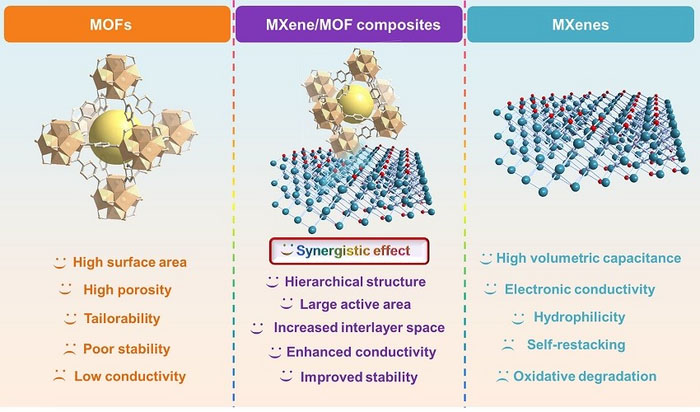| May 22, 2023 |
Metal-organic frameworks meet MXene: New opportunities for electrochemical application
(Nanowerk News) Metal-organic frameworks (MOFs) are materials that have gained significant attention in the field of energy due to their unique characteristics, like a high specific surface area, remarkable porous structure, and incredible adaptability. However, they've been held back by low electrical conductivity and chemical instability, which have been barriers to their wide-scale use.
|
|
Enter MXene, a new material with plentiful surface areas and high conductivity. This has been proposed as a potential solution to enhance the stability and conductivity of basic MOFs. The resulting MXene/MOF hybrids have better conductivity, more complex surface chemistry, and a multi-tiered structure that allows for faster movement of electrons and ions, resulting in improved electrochemical properties. These hybrids are even more impressive because they can be tailored into various forms, each with unique designs and improved electrochemical performance.
|
|
For this reason, the careful crafting of these MXene/MOF hybrids and their derivatives for use in energy-related devices is an area of great interest. To stimulate more research into these composites, scientists in China have reviewed the current state of research in this area and provided potential avenues for future exploration.
|
|
They published their work in Energy Material Advances ("Metal–Organic Frameworks Meet MXene: New Opportunities for Electrochemical Application").
|
 |
| Illustration of the characteristics of MOF, MXene, and MXene/MOF composites and their derivatives. (Image: Hui Yang, School of Chemistry and Chemical Engineering, Yangzhou University)
|
|
Huan Pang, professor at the School of Chemistry and Chemical Engineering, Yangzhou University, and author of a recent paper, stressed the significance of exploring MXene/MOF hybrid materials for their potential high electrochemical performance. "The relevance of MXene/MOF hybrids in energy-based applications is seeing a notable increase these days," he said.
|
|
Professor Pang elucidated the reasons why MXene/MOF hybrid materials are being designed. To begin with, MXenes have abundant negative surface charges that make them suitable substrates for MOFs to grow on. This not only prevents the clumping together of MOF particles and MXene sheets but also provides more available surface areas. Secondly, the MXene structure within these hybrids is highly conductive, offering efficient conductive paths and minimizing the ion-diffusion distance. Thirdly, the strong bonding between MXene and MOFs ensures excellent structure stability. Finally, the adjustable structure and various shapes of MOFs can help these hybrids cater to different specific applications. Thus, using MXene/MOF hybrids in high-performing electrochemical devices seems promising.
|
|
In his paper, Pang gave an exhaustive overview of the methods of creating MXene/MOF composites and the steps to produce MXene/MOF-derived materials. He also extensively examined and summarized the critical electrochemical applications of these composites and their derivatives. This includes uses in supercapacitors, various types of batteries, water splitting, and oxygen reduction reactions. "By introducing MXene, we can counteract the chemical instability and poor electrical conductivity of MOFs. Conversely, MOFs can address the issues of severe oxidation degradation and self-stacking of MXene," Pang explained. He added that MXene/MOF composites have been found to outperform pure MXene and original MOFs in electrochemical properties, owing to their well-planned structure, strong bonding, ample active sites, and wide-ranging conductive paths.
|
|
Even though there's been considerable progress in MXene/MOF composites and their derivatives, Pang pointed out that their application in electrochemistry is still nascent. He went on to discuss the key challenges and outlook for these composites. "It's crucial to increase the variety of MXene/MOF hybrids, improve their synthesis methods, build interfacial interactions, design complex structures, investigate MXene-derived MOF, create devices related to energy, and comprehend their working mechanisms," Pang outlined.
|
|
Despite the hurdles yet to be overcome for MXene/MOF composites and their derivatives, Pang noted their substantial contributions to electrochemical energy storage and conversion. "The review should foster a deeper understanding of functional MXene/MOF composites and pave the way for their future development in electrochemical applications," Pang concluded.
|

